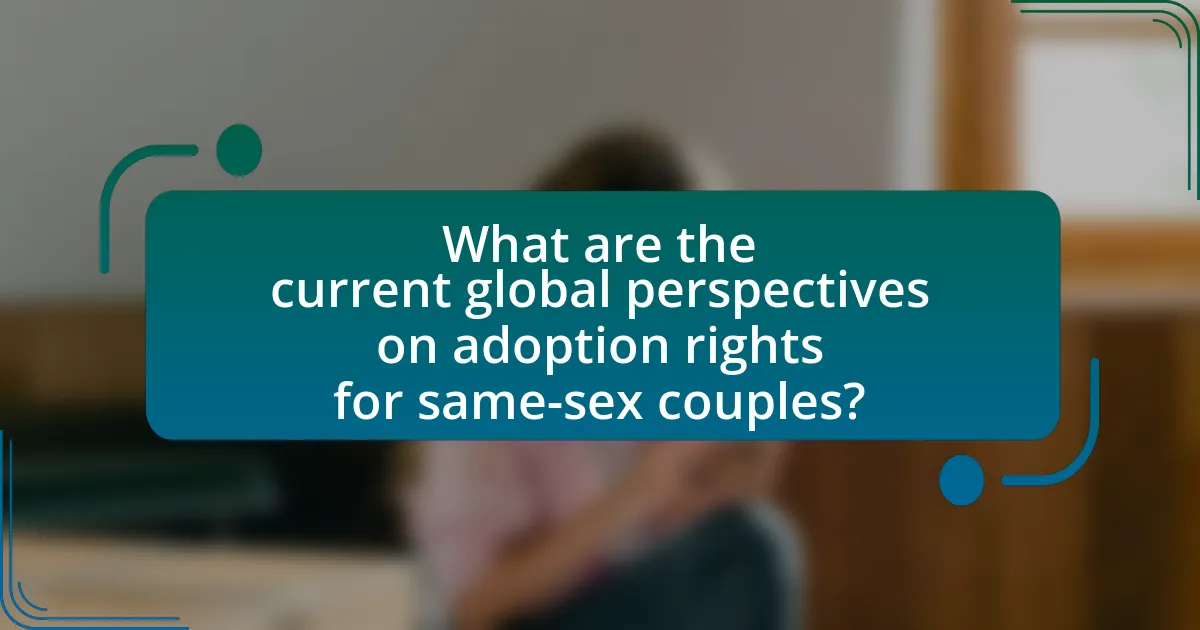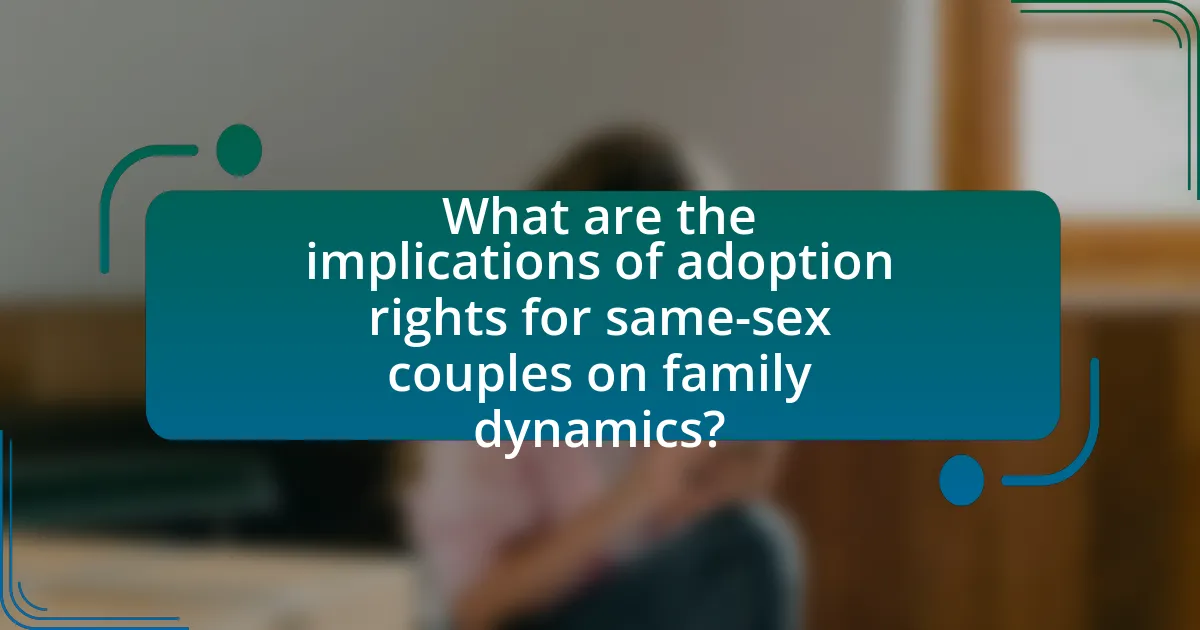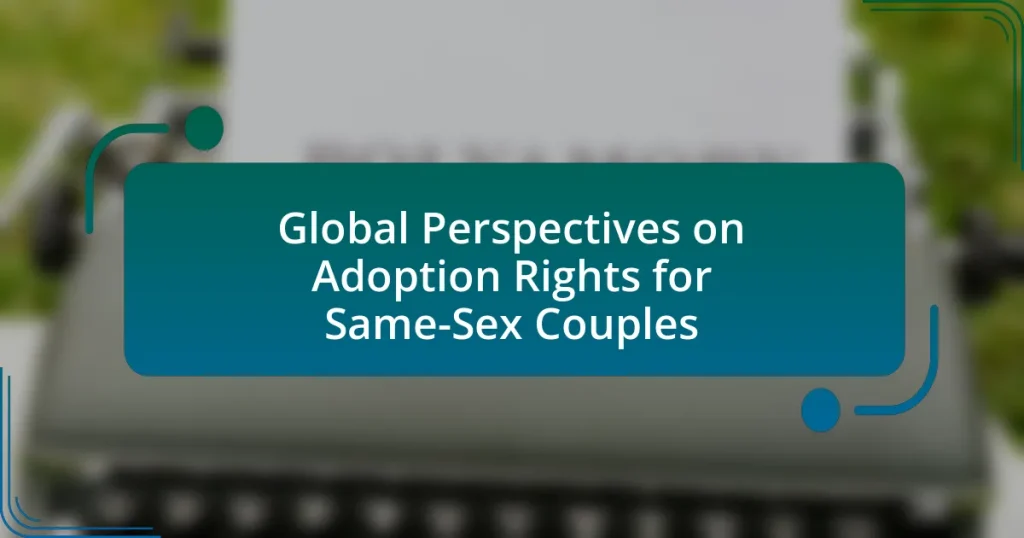The article examines global perspectives on adoption rights for same-sex couples, highlighting significant disparities in legal recognition across different countries. It outlines how nations like Canada, the Netherlands, and Spain fully support adoption rights for same-sex couples, while others, such as Russia and many regions in Africa and the Middle East, impose strict bans or limitations. The discussion includes the legal frameworks that facilitate adoption for same-sex couples, the barriers they face in restrictive countries, and the implications of these rights on family dynamics and child well-being. Additionally, the article addresses the role of public opinion, advocacy efforts, and historical developments that have shaped the current landscape of adoption rights for same-sex couples worldwide.

What are the current global perspectives on adoption rights for same-sex couples?
Current global perspectives on adoption rights for same-sex couples vary significantly, with some countries fully recognizing these rights while others impose strict limitations or outright bans. For instance, as of 2023, countries like Canada, the Netherlands, and Spain allow same-sex couples to adopt children on equal terms with heterosexual couples, reflecting progressive legal frameworks that support LGBTQ+ rights. Conversely, nations such as Russia and many parts of Africa and the Middle East maintain laws that prohibit same-sex couples from adopting, often citing cultural or religious reasons. This disparity highlights the ongoing global debate surrounding LGBTQ+ rights and family structures, with advocacy groups pushing for broader acceptance and legal recognition.
How do different countries approach adoption rights for same-sex couples?
Different countries have varying approaches to adoption rights for same-sex couples, with some fully recognizing their rights while others impose significant restrictions or outright bans. For instance, countries like Canada, the Netherlands, and Spain allow same-sex couples to adopt children on equal terms with heterosexual couples, reflecting progressive legal frameworks that support LGBTQ+ rights. In contrast, nations such as Russia and many parts of Eastern Europe have laws that prohibit same-sex couples from adopting, often citing traditional family values as justification. Additionally, countries like the United States exhibit a patchwork of laws, where adoption rights for same-sex couples can vary significantly by state, with some states providing full rights and others imposing limitations or bans. This disparity highlights the ongoing global debate surrounding LGBTQ+ rights and family structures.
What legal frameworks exist in countries that support same-sex adoption?
Countries that support same-sex adoption have established legal frameworks that vary widely. For example, in the United States, the Supreme Court’s 2015 ruling in Obergefell v. Hodges legalized same-sex marriage, which has led to increased recognition of same-sex couples’ rights to adopt in many states. Similarly, countries like Canada and the United Kingdom have comprehensive laws that explicitly allow same-sex couples to adopt children, with Canada’s Adoption Act and the UK’s Adoption and Children Act providing clear legal pathways. In contrast, some countries, such as Germany and Australia, have made significant strides in recent years, with legal reforms allowing same-sex adoption following landmark court decisions. These frameworks often include provisions that ensure non-discrimination based on sexual orientation, thereby reinforcing the rights of same-sex couples to adopt children.
What are the barriers faced by same-sex couples in countries that do not allow adoption?
Same-sex couples in countries that do not allow adoption face significant legal and social barriers. Legally, these couples are often denied the right to adopt due to discriminatory laws that explicitly exclude them from the adoption process, which can lead to a lack of legal recognition for their family units. Socially, they may encounter stigma and prejudice, which can further complicate their desire to form families and access necessary support systems. For instance, in countries like Russia and many parts of Africa, laws explicitly prohibit same-sex couples from adopting, reflecting broader societal attitudes that view same-sex relationships as illegitimate. This combination of legal restrictions and social discrimination creates a challenging environment for same-sex couples seeking to adopt.
Why is the recognition of adoption rights for same-sex couples important?
The recognition of adoption rights for same-sex couples is important because it ensures equal legal standing and protection for families formed by these couples. This recognition allows same-sex couples to provide stable, loving homes for children, which is crucial for the well-being and development of those children. Studies, such as those conducted by the American Psychological Association, have shown that children raised in same-sex households fare just as well as those raised in heterosexual households, demonstrating that the quality of parenting, rather than the sexual orientation of the parents, is what matters most for child development. Furthermore, legal recognition helps to eliminate discrimination and promotes social acceptance, contributing to a more inclusive society.
How does adoption impact the well-being of children in same-sex households?
Adoption positively impacts the well-being of children in same-sex households by providing them with stable, loving environments that contribute to their emotional and psychological development. Research indicates that children raised in same-sex households perform equally well in various aspects of life, including social skills, academic achievement, and mental health, compared to their peers in heterosexual households. A study published in the journal “Pediatrics” by researchers at the American Academy of Pediatrics found that children of same-sex parents show no significant differences in emotional well-being or behavioral issues compared to children of heterosexual parents. This evidence supports the conclusion that the quality of parenting and the family environment are more critical to child well-being than the sexual orientation of the parents.
What social and cultural factors influence the acceptance of same-sex adoption?
Social and cultural factors significantly influence the acceptance of same-sex adoption, primarily through societal attitudes, religious beliefs, and legal frameworks. Societal attitudes towards LGBTQ+ individuals play a crucial role; regions with higher acceptance of LGBTQ+ rights tend to show greater support for same-sex adoption. For instance, surveys indicate that countries like Canada and the Netherlands, which have progressive views on LGBTQ+ rights, also have legal provisions supporting same-sex adoption.
Religious beliefs can either hinder or promote acceptance; conservative religious groups often oppose same-sex adoption, while more liberal faith communities may support it. For example, in the United States, states with a higher concentration of conservative religious populations often have laws that restrict same-sex adoption, whereas states with more liberal religious affiliations tend to be more accepting.
Legal frameworks also shape acceptance; countries with comprehensive anti-discrimination laws and recognition of same-sex relationships generally exhibit higher acceptance rates for same-sex adoption. Data from the Williams Institute shows that in jurisdictions where same-sex marriage is legal, the acceptance of same-sex adoption is significantly higher, reflecting a broader societal shift towards equality.

What are the historical developments regarding adoption rights for same-sex couples?
Adoption rights for same-sex couples have evolved significantly over the past few decades, with key milestones marking this progress. In the early 1990s, the first legal recognition of same-sex couples’ adoption rights occurred in the United States when a court in Vermont ruled in favor of a same-sex couple adopting a child. By 2002, the Massachusetts Supreme Judicial Court became the first in the U.S. to rule that same-sex couples could adopt jointly.
Internationally, the Netherlands was the first country to legalize same-sex marriage in 2001, which included adoption rights for same-sex couples. Following this, countries like Spain and Canada also recognized these rights, with Canada legalizing same-sex marriage and adoption in 2005.
As of 2023, many countries, including the United Kingdom, South Africa, and several states in the U.S., have established legal frameworks that allow same-sex couples to adopt children, reflecting a broader acceptance of LGBTQ+ rights. These developments demonstrate a significant shift towards equality in adoption rights for same-sex couples globally.
How have legal changes evolved over the past few decades?
Legal changes regarding adoption rights for same-sex couples have significantly evolved over the past few decades, marked by a trend towards greater acceptance and legal recognition. In the 1990s, only a few jurisdictions allowed same-sex couples to adopt, but by 2023, many countries, including the United States, Canada, and several European nations, have enacted laws that permit same-sex couples to adopt children on equal terms with heterosexual couples. For instance, the U.S. Supreme Court’s 2015 decision in Obergefell v. Hodges legalized same-sex marriage nationwide, which subsequently influenced adoption rights, leading to broader legal protections for same-sex couples seeking to adopt. Additionally, as of 2023, over 30 countries have legalized adoption for same-sex couples, reflecting a significant shift in societal attitudes and legal frameworks towards LGBTQ+ rights.
What landmark cases have influenced adoption rights for same-sex couples?
The landmark case that significantly influenced adoption rights for same-sex couples is Obergefell v. Hodges (2015), which legalized same-sex marriage nationwide in the United States. This ruling established a legal foundation for same-sex couples to pursue adoption rights, as marriage is often a prerequisite for adoption in many jurisdictions. Additionally, cases like Adoptive Couple v. Baby Girl (2013) and the various rulings in state courts, such as the 2010 case of In re Adoption of T.A. (California), have further clarified and expanded the rights of same-sex couples in adoption processes. These cases collectively demonstrate the evolving legal landscape that supports the adoption rights of same-sex couples.
How have advocacy groups contributed to changes in adoption laws?
Advocacy groups have significantly influenced changes in adoption laws by actively campaigning for the rights of same-sex couples to adopt. These organizations, such as the Human Rights Campaign and Lambda Legal, have utilized legal challenges, public awareness campaigns, and lobbying efforts to highlight the discriminatory practices faced by same-sex couples in adoption processes. For instance, in 2015, the U.S. Supreme Court’s decision in Obergefell v. Hodges, which legalized same-sex marriage, was bolstered by advocacy efforts that emphasized the importance of equal adoption rights, leading to subsequent legal reforms in various states. Additionally, advocacy groups have provided legal resources and support to same-sex couples, facilitating their ability to navigate the adoption system and prompting legislative changes that promote inclusivity and equality in adoption laws.
What role does public opinion play in shaping adoption rights for same-sex couples?
Public opinion significantly influences the adoption rights of same-sex couples by shaping legislative agendas and societal norms. As public attitudes have shifted towards greater acceptance of LGBTQ+ rights, many jurisdictions have enacted laws that expand adoption rights for same-sex couples. For instance, a 2020 Gallup poll indicated that 67% of Americans supported same-sex marriage, reflecting a broader acceptance that has translated into legal reforms, such as the legalization of adoption for same-sex couples in various states. This correlation between public sentiment and policy change demonstrates that as societal acceptance grows, so too does the legal recognition of adoption rights for same-sex couples.
How do societal attitudes towards LGBTQ+ rights affect adoption policies?
Societal attitudes towards LGBTQ+ rights significantly influence adoption policies by determining the legal and social acceptance of same-sex couples as adoptive parents. In countries where positive attitudes towards LGBTQ+ individuals prevail, such as Canada and many Western European nations, adoption policies are often inclusive, allowing same-sex couples to adopt children on equal terms with heterosexual couples. Conversely, in regions with negative societal attitudes, such as parts of Eastern Europe and certain U.S. states, adoption policies may explicitly prohibit or restrict same-sex couples from adopting, reflecting the prevailing discrimination against LGBTQ+ individuals. For instance, a 2020 report by the Williams Institute found that in states with anti-LGBTQ+ laws, same-sex couples faced significant barriers in adoption processes, illustrating how societal perceptions directly shape legal frameworks.
What surveys or studies highlight public support for same-sex adoption?
Surveys and studies consistently indicate strong public support for same-sex adoption. For instance, a 2020 Gallup poll revealed that 70% of Americans support same-sex couples adopting children, reflecting a significant increase from 2002, when only 40% were in favor. Additionally, a 2019 study published in the Journal of Marriage and Family found that 63% of respondents supported adoption rights for same-sex couples, highlighting a growing acceptance over the years. These findings underscore a broader societal shift towards recognizing the rights of same-sex couples in parenting roles.

What are the implications of adoption rights for same-sex couples on family dynamics?
Adoption rights for same-sex couples significantly enhance family dynamics by promoting inclusivity and stability within families. Research indicates that children raised in households with same-sex parents experience similar emotional and psychological outcomes as those raised by heterosexual parents, suggesting that the quality of parenting is more critical than the sexual orientation of the parents. A study published in the journal “Pediatrics” found that children of same-sex couples showed no differences in behavioral or emotional health compared to their peers, reinforcing the idea that family structure does not dictate family quality. Furthermore, legal recognition of adoption rights fosters a sense of legitimacy and security for families, which can positively impact children’s development and well-being.
How do same-sex couples navigate the adoption process?
Same-sex couples navigate the adoption process by understanding and complying with the legal requirements specific to their jurisdiction. In many countries, same-sex couples face unique challenges, such as varying degrees of legal recognition and acceptance, which can affect their ability to adopt. For instance, in the United States, the Supreme Court’s 2015 ruling in Obergefell v. Hodges legalized same-sex marriage nationwide, subsequently influencing adoption rights, but state laws still vary significantly. Some states have inclusive policies that allow same-sex couples to adopt jointly, while others may impose restrictions or require additional legal steps. Research indicates that same-sex couples often seek legal counsel to navigate these complexities, ensuring they meet all necessary criteria and understand their rights throughout the process.
What challenges do same-sex couples face during the adoption journey?
Same-sex couples face significant legal and social challenges during the adoption journey. Legally, many jurisdictions do not recognize same-sex couples as equal to heterosexual couples in adoption rights, leading to barriers such as discriminatory laws or lack of legal recognition of their relationship. For instance, in some countries, same-sex couples may be outright banned from adopting or may face additional scrutiny during the adoption process compared to heterosexual couples. Socially, same-sex couples often encounter stigma and bias from adoption agencies, social workers, and even birth parents, which can complicate their ability to adopt. Research from the Williams Institute indicates that same-sex couples are more likely to experience discrimination in the adoption process, impacting their overall experience and success rates.
What resources are available to assist same-sex couples in adoption?
Same-sex couples can access various resources to assist in the adoption process, including legal advocacy organizations, adoption agencies specializing in LGBTQ+ families, and support groups. Organizations such as the Human Rights Campaign and Family Equality provide information on legal rights and resources specific to same-sex couples. Additionally, agencies like Rainbow Families and the North American Council on Adoptable Children offer tailored services and support for LGBTQ+ individuals seeking to adopt. These resources help navigate the complexities of adoption laws and provide community support, ensuring that same-sex couples have the necessary guidance throughout the adoption journey.
What best practices can be adopted to support same-sex couples in the adoption process?
Best practices to support same-sex couples in the adoption process include providing comprehensive training for adoption agencies on LGBTQ+ issues, ensuring non-discriminatory policies, and facilitating access to legal resources. Training adoption agency staff on LGBTQ+ cultural competency can reduce biases and improve the experience for same-sex couples. Non-discriminatory policies are essential, as they create an inclusive environment that recognizes the rights of same-sex couples to adopt. Additionally, access to legal resources helps couples navigate the complexities of adoption laws, which can vary significantly by jurisdiction. Research indicates that supportive environments lead to better outcomes for both adoptive parents and children, highlighting the importance of these practices in fostering successful adoptions.
How can legal professionals better assist same-sex couples in adoption cases?
Legal professionals can better assist same-sex couples in adoption cases by providing comprehensive legal guidance tailored to the unique challenges they face. This includes understanding and navigating the varying adoption laws across jurisdictions, as many regions have different regulations regarding same-sex adoption rights. For instance, in the United States, the 2015 Supreme Court ruling in Obergefell v. Hodges legalized same-sex marriage, which has implications for adoption rights, yet some states still impose restrictions. Legal professionals should also facilitate access to resources and support networks that specifically address the needs of LGBTQ+ families, ensuring that same-sex couples are informed about their rights and options throughout the adoption process.
What community resources can help same-sex couples during adoption?
Community resources that can help same-sex couples during adoption include LGBTQ+ advocacy organizations, legal aid services, and support groups. Organizations such as the Human Rights Campaign and Family Equality provide resources, guidance, and advocacy specifically tailored for LGBTQ+ families navigating the adoption process. Legal aid services can assist with understanding adoption laws and rights in various jurisdictions, ensuring that same-sex couples are informed of their legal standing. Additionally, support groups offer emotional support and shared experiences, which can be invaluable during the adoption journey. These resources collectively empower same-sex couples by providing essential information, legal assistance, and community support.


